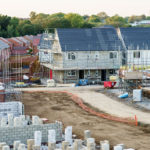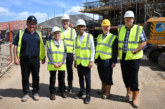Prime Minister, Rishi Sunak announced today (24th July) that the Government will meet its manifesto commitment to build one million homes over this Parliament. The announcement was made ahead of Levelling Up Secretary, Michael Gove’s speech setting out a long-term plan for housing and new measures to unblock the planning system and build more homes in the right places where there is local consent.
The Prime Minister and the Secretary of State for Levelling Up, Housing and Communities announce a ‘new era of regeneration, inner-city densification and housing delivery across England, with transformational plans to supply beautiful, safe, decent homes in places with high-growth potential in partnership with local communities’, as described on government’s website.
Amongst the pledges, the Levelling Up Secretary announced the regeneration and renaissance of a further three English cities, committing to transformational change in Cambridge, central London and central Leeds, as well as allocating £800m from the £1.5bn Brownfield, Infrastructure and Land fund to unlock up to 56,000 new homes on brownfield sites. An additional £550m funding has been announced for Homes England, which with income generated will mean a total investment of £1bn says government.
The Levelling Up Secretary also announced landmark investments of £150m to Greater Manchester and £100m to the West Midlands, as well as additional reforms to the planning system, through which government aims to ‘speed up new developments, put power in the hands of local communities to build their own homes, and unlock planning decisions’. A new £24m fund has been announced to scale up local planning capacity, and an additional £13.5m to stand up a new “super-squad” of experts to support large-scale development projects.
Prime Minister Rishi Sunak said: “Today I can confirm that we will meet our manifesto commitment to build one million homes over this Parliament. That’s a beautiful new home for a million individual families in every corner of our country.
“We need to keep going because we want more people to realise the dream of owning their own home.
“We won’t do that by concreting over the countryside — our plan is to build the right homes where there is the most need and where there is local support, in the heart of Britain’s great cities.
“Our reforms today will help make that a reality, by regenerating disused brownfield land, streamlining planning process and helping homeowners to renovate and extend their houses outwards and upwards.”
Secretary of State for Levelling Up, Housing and Communities Michael Gove said: “Most people agree that we need to build more homes — the question is how we go about it.
“Rather than concreting over the countryside, we have set out a plan today to build the right homes in the right places where there is community support – and we’re putting the resources behind it to help make this vision a reality.
“At the heart of this is making sure that we build beautiful and empower communities to have a say in the development in their area.”
Here we garner opinion from across the sector to the announcements…
Further expanding permitted development rights risks creating poor quality residential environments that negatively impact people’s health and wellbeing
Cllr Shaun Davies, Chair of the Local Government Association said: “There is no doubt that we need more homes as well as to reinvigorate our high streets and town centres. However, premises such as offices, barns, and shops are not always suitable for housing.
“Further expanding permitted development rights risks creating poor quality residential environments that negatively impact people’s health and wellbeing, as well as a lack of affordable housing or suitable infrastructure.
“Councils support the Government’s ambition for the right homes in the right areas, which can have significant wider benefits for people and communities, and prevent future public service challenges and costs.
“To deliver these benefits, the Government should support our six-point plan, which would lead to a generational step-change in council housebuilding and give local government the powers and funding to deliver thousands of social homes a year.”
Whilst long-term plan for housing is a positive start, it is nowhere near the scale or ambition that is needed
Rhys Moore, Executive Director of Public Impact at the National Housing Federation commented: “We have been calling for a long-term plan for housing and whilst this is a positive start, it is nowhere near the scale or ambition that is needed. We have a massive housing crisis on our hands with one in six children living in overcrowded homes and 4.2 million people in need of social housing. “We welcome the commitments to planning interventions however this is relatively piece meal given the challenge we face.
“There is also nothing in this announcement about investing in social housing which is sorely needed. We have a chronic shortage of social homes in this country, caused by decades of underinvestment by successive governments and this has exacerbated the rental crisis and increased house prices. Last year we only built around 6,500 social rented homes compared to the 90,000 a year that are needed.
“We need a strategic, nationally coordinated and properly funded long-term housing plan, focused on drastically increasing social housing across the country, which this is not.”
Focus must be on boosting delivery of affordable homes
London Councils has responded to the Government’s announcement on building new homes and the Secretary of State’s speech on reforming the planning system and regenerating urban areas.
Cllr Darren Rodwell, London Councils’ Executive Member for Regeneration, Housing & Planning, said: “Boroughs are ready and willing to help deliver the homes our communities need, but this requires more local powers and resources for housebuilding.
“Despite massive challenges, boroughs are working hard to accelerate housebuilding and have made solid progress in recent years. London saw more council-built homes started in 2022 than any year since the 1970s.
“There are at least 143,000 potential new homes we could begin building immediately in London if the funding was in place, and we would welcome the prospect of enhanced government support for housing development and regeneration. We are calling for reform of Right to Buy receipts, increased grant allocations, and investment in new infrastructure so that we can truly turbocharge affordable housebuilding.
“The chronic shortage of affordable housing is the critical factor behind London’s skyrocketing homelessness figures. The situation is utterly unsustainable. There are 166,000 homeless Londoners living in temporary accommodation, including on average at least one homeless child in every London classroom.
“The focus must be on boosting delivery of affordable, high-quality homes. The government’s pledge to expand permitted development rights does not guarantee this will happen – in fact it brings serious risks. Boroughs must retain the ability to ensure housing is built to the right standards, in suitable locations, and with the necessary local infrastructure such as GP surgeries and transport connections.”
UKGBC warns against cuts to environmental housing standards
Simon McWhirter, UKGBC Deputy Chief Executive said: “The Government is right to focus on building more homes in urban areas but unblocking the planning system shouldn’t mean cutting environmental corners.
“Instead, the Government should seize this moment to bring the planning system into line with our Climate Change and Environment Acts so that communities and developers alike can have confidence that only high-quality green homes get the go-ahead in the right places. We need to end the planning barriers that are blocking the solar panels, heat pumps and insulation urgently needed to modernise our homes, which the Government can achieve by amending the Levelling Up and Regeneration Bill after the summer.
“The forthcoming Future Homes Standard is another critical opportunity to ensure the tens of thousands of homes set to be built are super-insulated and fit for our low-carbon economy. The next generation of homes must not repeat the mistakes of the past by saddling households with unaffordable energy bills, high retrofit costs, or landing us all with the cost of unnecessarily large electricity grid upgrades.
“Renters in cold damp homes have long been waiting for stronger minimum energy efficiency standards, so the Government must urgently bring this forward.
“We will need to convert unused commercial buildings on our high streets into homes, but only where they can meet basic standards of space and natural light.
“With climate breakdown at our door, every housing development and planning decision must help us cut carbon emissions, adapt to high temperatures, floods and drought, and restore biodiversity, or we risk a backwards step for households and our planet.”
Funding for more planning experts welcome
Mark Reynolds, Chief Executive, Mace said: “One of our biggest challenge as an industry is a lack of clarity over the future pipeline of construction work across the UK. This welcome funding for more planning experts will help to decrease waiting times for planning decisions — a major cause of uncertainty and delay in delivery across the construction sector — and a review of permitted development rights could help to unlock UK-wide growth through the opportunity for more work across the country for the repair, maintenance and improvement sector.”
We should aim to deliver quality as well as quantity
Jack Pringle, Chair of the RIBA Board commented: “We pleased to see today’s announcements which will enable the vital action needed to tackle the housing crisis. Measures to increase planning resource are welcome and critical to build the homes that we need. New homes do need to be delivered at pace, and we should aim to deliver quality as well as quantity. We remain committed to working with our partners in government to deliver well-designed, accessible and sustainable homes in the places that need them most.”
Placemaking recommendations taking centre stage
Ike Ijeh Head of Housing, Architecture and Urban Space at Policy Exchange said: “Policy Exchange is delighted to see key recommendations of its recently published Placemaking Matrix incorporated into the Government’s new plans. Both the report and our groundbreaking ‘Building More, Building Beautiful’ paper co-authored by the late Sir Roger Scruton were invested in the founding principle that improving the quality and quantity of UK housing is simply not possible without an aggressive focus on urban quality and democratic consent. It is therefore encouraging to see these ideas take centre stage in the Government’s new proposals.”
Investment in planning will help alleviate pressure on England’s planning services
Victoria Hills, Chief Executive, Royal Town Planning Institute commented: “I believe this investment into the planning system will make a significant contribution to alleviating the pressure placed on England’s planning services. Well-resourced Local Planning Authorities have the power to make a unique contribution to their areas, helping to deliver the affordable homes, public services, and critical infrastructure individuals, families and communities need.”
Investment in planning welcome
Andrew Davies, CEO, Kier Group said: “Construction and Infrastructure have a key role to play in supporting economic growth. As such, any steps taken to speed up planning consents and invest in the improvement and regeneration of communities are welcome.”
Housing crisis can be met solely through brownfield development
Colin Brown, Head of Planning & Development at Carter Jonas commented: “There is some encouragement in relation to suggestions of new lines of funding to help local authorities with their significant workload / backlogs.
“Development corporations may well have a place if the Government genuinely wishes to ramp up delivery, for example in Cambridge. Cambridge is however surrounded by a Green Belt so significant questions will remain as to how you capitalise on its ongoing potential without recognising that some green belt development will almost certainly be needed. How you leverage in new infrastructure is a further key question.
“What seems clear however is that national housing targets look set to be abandoned. The reference to urban areas and brownfield sites anticipates the fact that greenfield development in areas of greatest housing need do not really feature.
“While we would support use of brownfield land it is simply incorrect to suggest that the housing crisis can be met in this way. Greenfield and green belt land will both need to be considered.”
Planning skills delivery fund a step in the right direction, but we need to ensure planners have expertise in modular housing too
Verity Davidge, Director of Policy, Make UK Modular said: “Today’s announcement to manage the housing planning backlog through a planning skills delivery fund is a step in the right direction. Part of the fund should be dedicated towards ensuring planners have the knowledge and expertise of modular housebuilding too, which can help tackle the housing crisis we face in the UK.
“That said, these policies only begin to scratch the surface and we need to see more ambitious reforms to housing. Lowering stamp duty for EPC A rated homes and allocating a higher proportion of the affordable housing programme to modular housing would unleash the potential of a dynamic and innovative sector able to provide homes greener, faster and better.”
Refusal to consider release of greenbelt — which may itself be brownfield — highlights a refusal to properly engage with the issues
Paul Wakefield, Planning Partner, Shakespeare Martineau, commented: “The Government is seeking to focus on brownfield development rather than greenbelt erosion. This once again illustrates the misconception of the nature of the greenbelt. It’s not equivalent to greenfield, but rather a spatial policy intended to prevent urban coalescence. Whilst the desire for gentle densification of cities is generally a positive, the repeated refusal to consider release of greenbelt — which may itself be brownfield — highlights a refusal to properly engage with the issues, which continues to hold the country back.
“It also doesn’t sit well with the praise and desire for garden towns and cities, which are inevitably remote from existing transport links and services. It therefore sits completely at odds with the first half of the speech, which seeks to focus on growth in existing towns and cities.
“Furthermore, £24m in funding to local planning authorities to improve delivery sounds impressive, but with 317 Local Planning Authorities (LPA) in England it averages out at £75,709.78 per LPA, which is unlikely to significantly improve service delivery.”
Ramping up construction should never come at the cost of quality
Maria Hudson, CMO at construction software specialists Zutec, said: “There’s no doubt we urgently need to build more housing stock, both private and social. However ramping up construction should never come at the cost of quality, which is why it’s so important that future developments align with the new regulatory framework. I think the Secretary of State realises this, given the persistence of safety and maintenance-related issues post-Grenfell.
“Yes, things like Part L, the BSA and the recently introduced second staircase requirement will make the build process longer, but are essential to achieve the safe and sustainable homes people rightly expect. Of course, developers can ease the legal and legislative pressure with the right tech in place to support the build journey, from design to handover. The good news is it’s now mainstream, and affordable, making it easier than ever to comply with Government requirements.”
Solving the housng crisis is entirely feasible is the industry is willing to look beyond tradirtional construction methods
Dr Mila Duncheva, Business Development Manager of UK & Ireland, Stora Enso, a leading provider of renewable products in packaging, biomaterials, and wooden construction, commented: “It’s clear from the UK Government’s targets that the challenge to meet our housing demands looms large, and it is great to see the unlocking of commercial premises and agricultural buildings for conversion into homes in the new planning changes. Building with modern methods of construction (MMC) and prefabricated wooden components offers rapid build times with millimeter-precision for converting and extending existing structures. Solving the housing shortage at speed, and with sustainability in mind, is not just visionary but entirely feasible if the industry is willing to look beyond traditional modes and level up its construction methods.”










